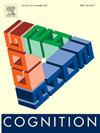观察者将其他智能体的高阶目标信息转化为对其即将到来的行动运动学的期望
IF 2.8
1区 心理学
Q1 PSYCHOLOGY, EXPERIMENTAL
引用次数: 0
摘要
社会感知依赖于理解驱动他人行为的高阶目标的能力。在预测编码的观点下,这种能力依赖于类似贝叶斯的假设测试机制,该机制将先前关于另一个代理目标的高阶信息转化为对这些目标可以实现的行动的感知预测,并根据实际行为测试这些预测。我们在三个预先注册的实验中验证了这一假设。参与者看到一个智能体的手靠近两个可能的目标物体(例如,甜甜圈,锤子),并听到智能体陈述一个高阶目标,这个目标可以由两个物体中的一个来实现(例如,“我真的很饿!”)。然后,这只手伸向物体,在运动过程中消失在一个不可预测的点上,参与者报告了它最后出现的位置。结果揭示了先前目标和观察到的手轨迹的假设整合。报告的手消失点被预测地转移到目标可以最好地实现的物体上。当目标陈述被明确处理(实验1)时,这些偏差比被动听到(实验2)时更强,在更模糊的到达时更强,并且它们不能用注意力转向物体或参与者对实验假设的意识来解释。此外,当代理的陈述提到相同的对象但没有将其指定为行动目标(例如,“我真的不饿!”)时,不会引发类似的偏见(实验3)。这些发现将行为理解与社会知觉和心理理论的预测/贝叶斯机制联系起来,并首次提供证据表明,对他人较高水平目标的先验知识会级联到较低水平的行动期望,并最终影响他人行为的视觉空间表征。本文章由计算机程序翻译,如有差异,请以英文原文为准。
Observers translate information about other agents' higher-order goals into expectations about their forthcoming action kinematics
Social perception relies on the ability to understand the higher-order goals that drive other people's behaviour. Under predictive coding views, this ability relies on a Bayesian-like hypothesis-testing mechanism, which translates prior higher-order information about another agent's goals into perceptual predictions of the actions with which these goals can be realised and tests these predictions against the actual behaviour. We tested this hypothesis in three preregistered experiments. Participants viewed an agent's hand next to two possible target objects (e.g., donut, hammer) and heard the agent state a higher-order goal, which could be fulfilled by one of the two objects (e.g., “I'm really hungry!”). The hand then reached towards the objects and disappeared at an unpredictable point mid-motion, and participants reported its last seen location. The results revealed the hypothesized integration of prior goals and observed hand trajectories. Reported hand disappearance points were predictively shifted towards the object with which the goal could be best realised. These biases were stronger when goal statements were explicitly processed (Experiment 1) than when passively heard (Experiment 2), more robust for more ambiguous reaches, and they could not be explained by attentional shifts towards the objects or participants' awareness of the experimental hypotheses. Moreover, similar biases were not elicited (Experiment 3) when the agent's statements referred to the same objects but did not specify them as action goals (e.g., “I'm really not hungry!”). These findings link action understanding to predictive/Bayesian mechanisms of social perception and Theory of Mind and provide the first evidence that prior knowledge about others' higher-level goals cascades to lower-level action expectations, which ultimately influence the visuospatial representation of others' behaviour.
求助全文
通过发布文献求助,成功后即可免费获取论文全文。
去求助
来源期刊

Cognition
PSYCHOLOGY, EXPERIMENTAL-
CiteScore
6.40
自引率
5.90%
发文量
283
期刊介绍:
Cognition is an international journal that publishes theoretical and experimental papers on the study of the mind. It covers a wide variety of subjects concerning all the different aspects of cognition, ranging from biological and experimental studies to formal analysis. Contributions from the fields of psychology, neuroscience, linguistics, computer science, mathematics, ethology and philosophy are welcome in this journal provided that they have some bearing on the functioning of the mind. In addition, the journal serves as a forum for discussion of social and political aspects of cognitive science.
 求助内容:
求助内容: 应助结果提醒方式:
应助结果提醒方式:


